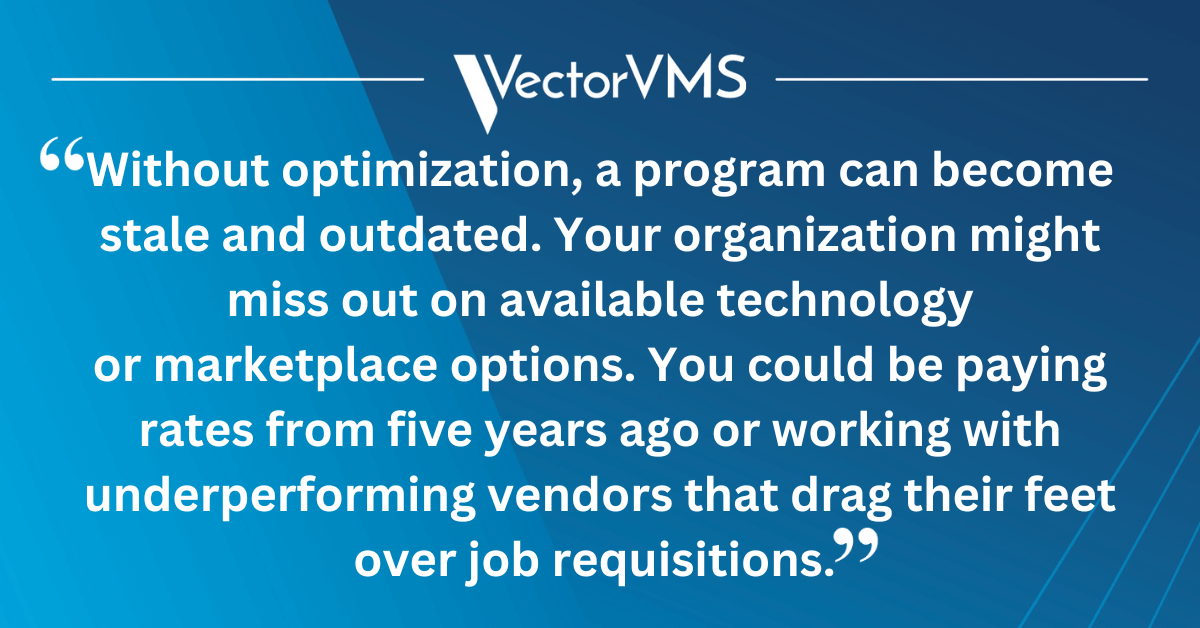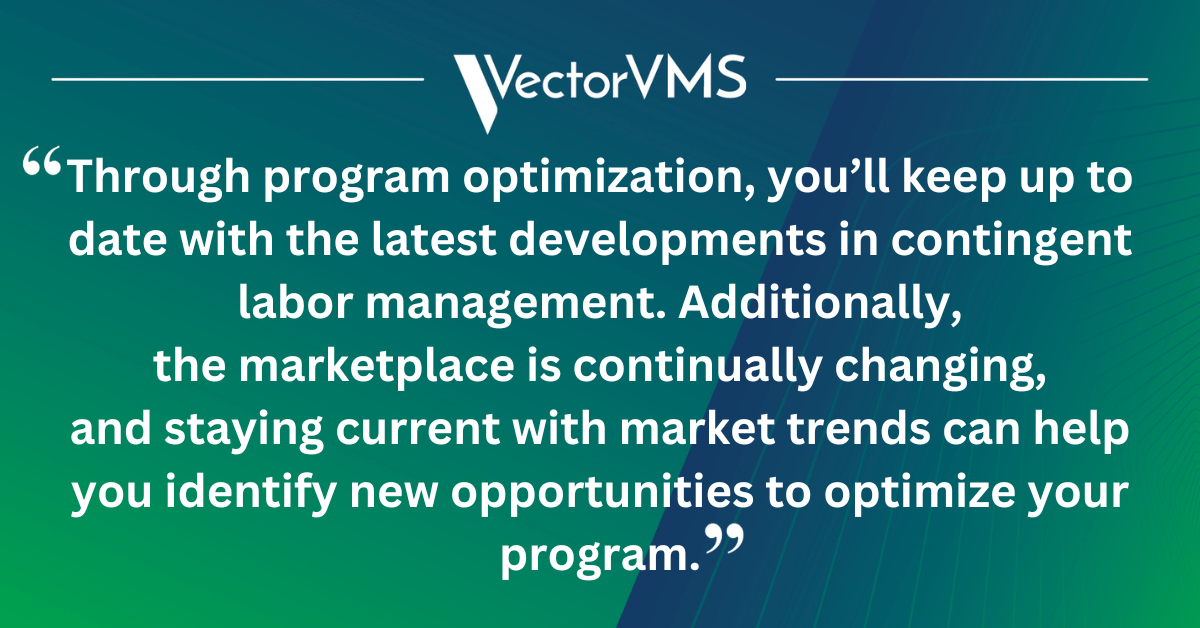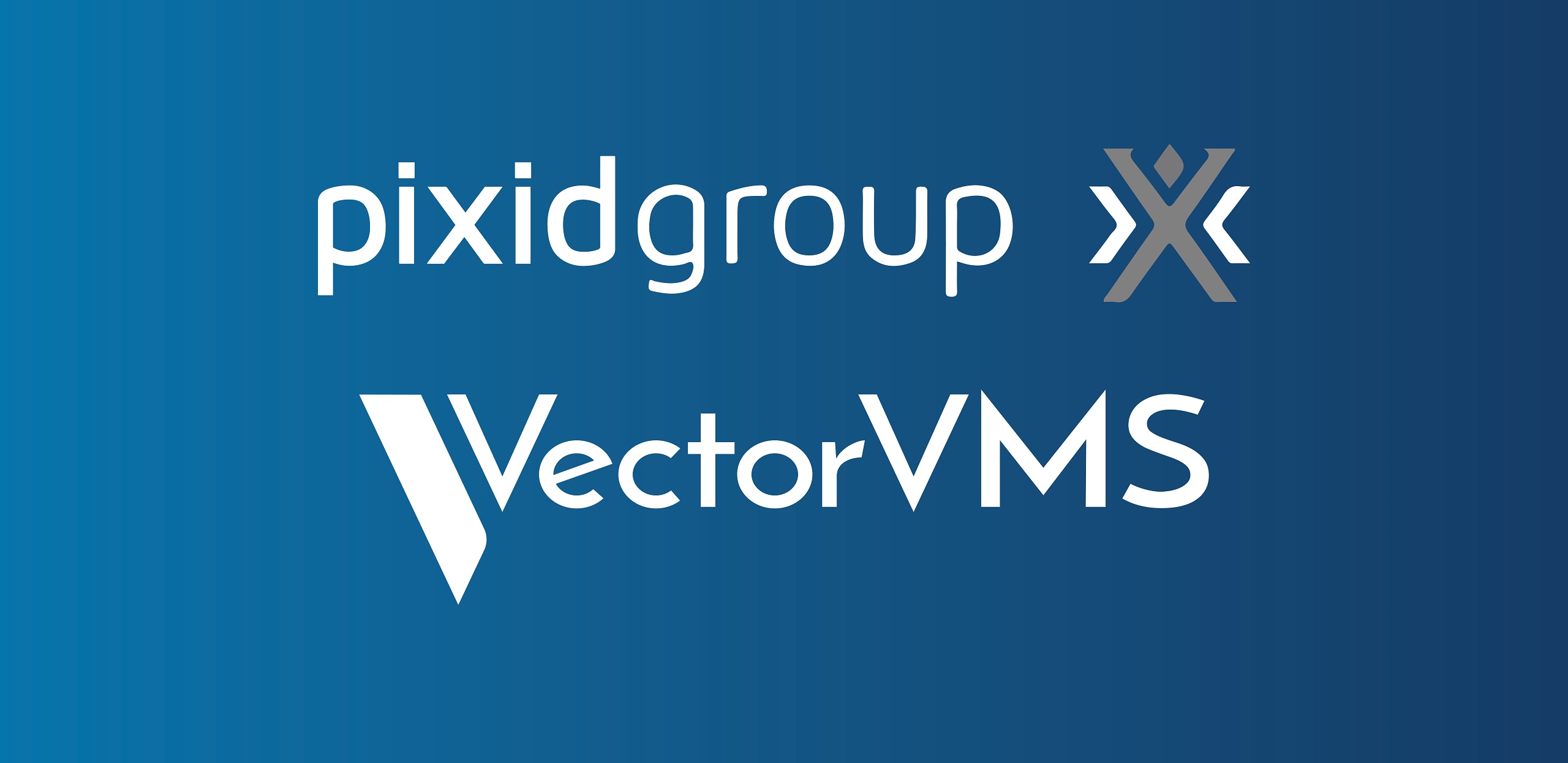As organizations strive to remain competitive, flexible, and scalable, the use of contingent labor has become increasingly popular. Contingent talent, from freelancers to independent contractors or temporary staff, offers businesses a wide range of benefits that are sometimes hard to find in traditional hiring arrangements. When coupled with a vendor management system (VMS), your contingent workforce program can provide flexibility, cost savings, and effectiveness in finding qualified talent.
However, working with contingent talent comes with its own set of struggles. Legal or compliance issues, slow onboarding-offboarding processes, or lower retention rates are some of the most common issues organizations face when bringing along extended labor. This is the reason why any contingent workforce program requires a strategic and organized optimization process.
What’s Program Optimization?
Without optimization, a program can become stale and outdated. Your organization might miss out on available technology or marketplace options. You could be paying rates from five years ago or working with underperforming vendors that drag their feet over job requisitions.
Contingent workforce program optimization will prevent these issues and ensure that organizations are making the best use of all the contingent talent available and of all the advantages of your program. With a properly optimized program, your organization will be better able to find quality talent faster, maintain compliance, and obtain the best rates.

3 Benefits of Program Optimization
Every contingent workforce program needs to be regularly optimized, no matter how big or small. What optimization means for your program will depend on your current challenges and goals, but overall it refers to a process of improving the effectiveness and efficiency of every step over time to achieve optimal results. It can involve analyzing data, identifying inefficiencies, or implementing changes to increase program success.
Transforming your program from a shorter-term tactical approach to a longer-term strategic one is a gradual process. Here are three benefits that such an approach can yield.
1) Program Optimization Allows You to Make the Most Out of Technology
Through program optimization, you’ll keep up to date with the latest developments in contingent labor management. Additionally, the marketplace is continually changing, and staying current with market trends can help you identify new opportunities to optimize your program.

2) Program Optimization Reduces Costs
Optimizing a contingent workforce program can result in significant cost savings. By identifying and eliminating inefficiencies, organizations can reduce their overall spending on contingent workers.
YOU MIGHT BE INTERESTED IN READING | ‘3 Strategies for Maintaining Healthy Finances with Vendors in a Contingent Workforce Program’
3) Optimization Helps You Maintain a Healthy Program
As your organization and your industry evolve, so will your contingent labor needs. For example, a company may need more IT professionals one year and more marketing professionals the next. If you regularly review and optimize your program, you’ll ensure that it aligns every year with your current goals and challenges, leading to a healthy and successful program.
Ensuring Your Optimization Efforts Bring Good Results
To ensure your optimization efforts deliver the desired results, make sure to:
- Communicate clearly and effectively with stakeholders. Develop a comprehensive communication plan so that everyone understands program goals, requirements, and expectations, and can collaborate effectively.
- Set performance metrics. Track key performance indicators (KPIs) that allow you to gain insight into program performance.
- Schedule regular program reviews. Establishing a consistent optimization process is crucial in identifying areas where your contingent workforce program may be underperforming. Through regular reviews and assessments, you can uncover opportunities for improvement and make the necessary changes to enhance your program’s performance.
LEARN MORE | ‘4 Vendor Management Improvements You Might Be Missing’
Elevate Your Program With the Right Ally
As the world of work continues to evolve at a rapid pace, keeping a contingent workforce program optimized is becoming increasingly complex. Although optimization is key to a successful program, it’s true that not all organizations have the bandwidth to implement it. In this scenario, organizations can leverage a solution like VectorVMS’s Shared Managed Services (SMS) program.
SMS is a hybrid program that provides comprehensive support for all your optimization needs, from implementation to ongoing management. It allows you to directly manage your contingent workforce program while still receiving specialized services of your choosing, such as program optimization. You can rest easy knowing that your contingent workforce program is being examined by a group of experts and that your organization is operating at peak efficiency.
Learn more about program optimization and how VectorVMS’s Shared Managed Services can improve your contingent workforce program. Download our ebook ‘Optimizing Your Contingent Workforce: 4 Essential Areas to Focus for Maximum Performance’. Alternatively, get in touch with us and start revolutionizing your program!
 Meet the Expert
Meet the Expert
Jay Grissom – Vice President of Account Management & Operations
Jay Grissom has more than 22 years of experience in managing contingent workforce solutions. He leads the VectorVMS team of program managers, who help clients optimize their contingent workforce programs through strategic planning, process improvements, and compliance and operational services. He also manages a team of consultants who lead implementation and ensure VectorVMS clients are able to achieve their workforce strategy with our vendor management system. Jay’s prior experience includes leading HR staffing teams at IBM, where he was responsible for full lifecycle recruitment, implementation of an applicant tracking system (ATS), and driving compliance.
He has developed the overall strategy for and executed vendor management systems for Fortune 500 companies across both the US and Canada. He is committed to working closely with his team to ensure client satisfaction is achieved, and to ensure our products align with, and promote, our clients’ goals and objectives. Connect with him on LinkedIn.



